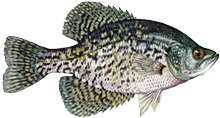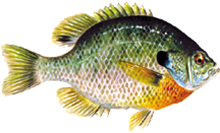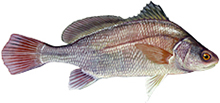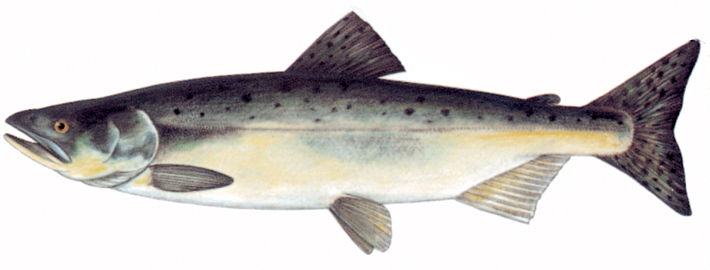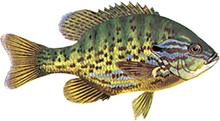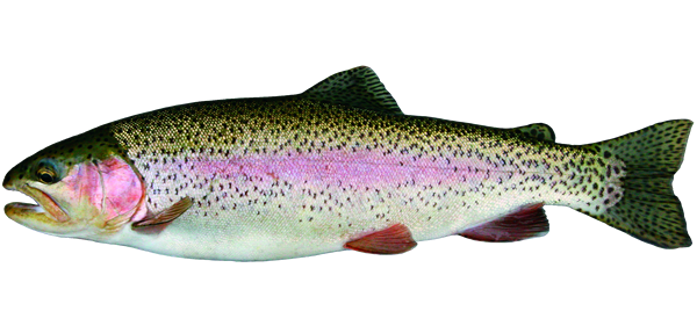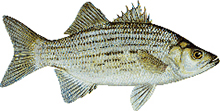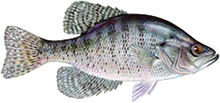Guide to Eating Ontario Fish
Use this guide, also referred to as the Guide to Eating Sportfish and Fish Guide, and interactive map to help you identify and prepare the types and amounts of fish that are safe to eat, from more than 2,700 fishing locations in Ontario.
About the guide
Fish can be an important part of a balanced diet. They are a great source of high-quality protein, beneficial Omega-3 fats and other nutrients.
While eating fish is part of a healthy diet, fish can sometimes contain harmful contaminants from natural sources or human activities. Based on their size, type and location, certain fish may be more suitable to eat than others.
This guide provides easy-to-use information to help the general population and sensitive populations (for example, children under 15 years old and anyone who is pregnant or may become pregnant) choose fish caught from Ontario lakes and rivers to eat, while minimizing exposure to toxins.
We collect fish for contaminant analysis through the Fish Contaminant Monitoring Program. We assess measured contaminant levels to determine how many fish meals a person can safely eat per month for the type, size and location where the fish was caught. The type and amount of Ontario fish that are safe to eat (called “consumption advice” or advisories) are generally based on guidelines provided by Health Canada.
Visit the interactive map featuring more than 2,700 fishing locations in the province. Click on a location to check the advisories for eating fish in that area.
For certain locations, we may give consumption advice for specific species and/or size ranges that are not legal to possess under Ontario’s fishing regulations. Before you go fishing, make sure:
- it is legal to fish in the area
- you have the required licence
- you are aware of any size or catch limits
Learn more about fishing in Ontario.
Ontario is not the only area to have consumption restrictions on fish. Most jurisdictions in North America have them. Read the review of consumption restrictions on fish in North America.
For information on the health implications of contaminants:
- visit Health Canada's website
- call Health Canada at
1-866-225-0709
Map and consumption advisories
Use the interactive map below to search for and view consumption advice for fish from over 2,700 lakes and rivers in Ontario.
All consumption advisory data are also available on the Open Data Catalogue.
Find a map error?
It is possible you may encounter inaccuracies with map locations.
If you find an error in the location of a lake, river or stream, please contact us. Use the Report an error link within the map pop-up.
Comments
For comments and suggestions, email us at fishguide@ontario.ca.
Understanding the advisory tables
The fish consumption advisory tables will appear on a new webpage after you select the fishing location from the map. These advisory tables show the recommended maximum number of fish meals per month for general and sensitive populations, by fish species and size (length of the fish) as long as you don’t eat fish from any other location or category. You may eat fish from different categories and locations as long as you track what you have eaten.
The superscript (small) number on the upper right of the fish species’ name identifies the contaminant or group of contaminants that are prompting the consumption advisories. These contaminants are listed in the contaminants in fish section on this page.
Learn how to use the map to find the amount of Ontario fish you can safely eat.
How to use the map to find the amount of fish you can safely eat
This guide provides advice about the number of fish meals per month that a person can safely eat for a particular type and size of fish, caught from a specific location.
Consumption advice in this guide is provided for both the general population and the sensitive population (anyone who is pregnant or may become pregnant and children under 15 years old).
Consumption advice in the guide depends on:
- the lake or river where the fish was caught
- the type of fish caught (fish species)
- the length of the fish from tip of the nose to the tip of the tail, in centimetres or inches
Step 1
Go to the interactive map and type the name of the waterbody (lake or river) where you caught the fish into the search bar. You can also browse the map to select a location where you caught the fish.
Click the yellow circle on the map to display a pop-up window. In the pop-up, select “Consumption advisory table.” This will open a new fish consumption advisory webpage for your location.
Step 2
Identify and select the type of fish you caught. If you are not sure what type of fish you have caught, read the Learn how to identify fish section on this page.
Step 3
Measure the total length of the fish from the tip of the nose to the tip of the tail, in either centimetres or inches. In the advisory table for your fish species, find the correct length range either:
- across the top first row, for length in centimetres
- in the second row, for length in inches
| Length (cm) | 15–20 | 20–25 | 25–30 | 30–35 | 35–40 | 40–45 | 45–50 |
|---|---|---|---|---|---|---|---|
| Length (in) | 6–8 | 8–10 | 10–12 | 12–14 | 14–16 | 16–18 | 18–20 |
| General population | N/A | N/A | N/A | 8 | N/A | N/A | 4 |
| Sensitive population* | N/A | N/A | N/A | 4 | N/A | N/A | 0 |
Note: An angler catches a 33 cm (13 in) Walleye from Lake and wants to determine how many meals of fish they can eat in a month. Using the length of the fish across the top of the table, the advice given for Walleye in the 30-35 cm (12–14 in) is 8 for the general population and 4 for the sensitive population indicating that no more than 8 meals per month of that fish can be safely eaten by the general population and no more than 4 meals per month for the sensitive population. You may need to use the scroll bar at the bottom of the table to find the correct length range for the fish.
Step 4
The third and fourth rows of the advisory table show you how many meals of that fish you can eat in a month, depending on whether you belong to the general or sensitive population.
Use the number in the advisory table, under the size of fish you caught, to learn how many meals you can eat in a month. This number represents the maximum number of meals of that size of fish, from that location, that can be eaten each month, as long as you don’t eat fish from any other location or category.
For example, for a Walleye caught in Lake that is 33 cm or 13 inches long:
- the general population is advised to eat no more than 8 fish meals per month
- the sensitive population is advised to eat no more than 4 meals fish meals per month
Step 5
Keep track of your total monthly meals to make sure you are eating no more than 100% of your advised total monthly consumption.
You may eat fish from different categories and locations as long as you track what you have eaten.
The table below converts the number of fish meals per month into a percentage. You can use this to add the consumption advice together for fish meals from different sized fish, fish species or locations.
The total amount consumed over one month should be no more than 100% of your advised total monthly consumption.
| Category (number of fish meals you have eaten per month) | Fraction of monthly intake total | Percentage of monthly intake total % |
|---|---|---|
| 32 | 1⁄32 | 3.1 |
| 16 | 1⁄16 | 6.3 |
| 12 | 1⁄12 | 8.3 |
| 8 | 1⁄8 | 12.5 |
| 4 | 1⁄4 | 25 |
| 2 | 1⁄2 | 50 |
| 1 | 1 | 100 |
For example, if you eat:
- two meals in the 12-meal-per-month category, each meal will represent one-twelfth or 8.3% of your maximum monthly advised consumption for a total of one-sixth or 16.6% of your maximum monthly advised consumption (2 meals × 1⁄12 = 1⁄6 or 16.6%)
- one meal in the two-meal-per-month category, that meal will represent one-half or 50% of your monthly advised consumption (1 meal × 0.5 = 0.5 or 50%)
The total from these two groups equals 66.6% of your 100% total monthly advised consumption, so you can consume more fish up to a total of 100%.
Number of fish fillets in one fish meal
Our consumption advice is based on an average fish meal of 227 grams (8 ounces, half a pound or approximately a fillet of dinner plate length) for an average-size adult weighing 70 kilograms (154 pounds).
A visual guide to fish serving sizes
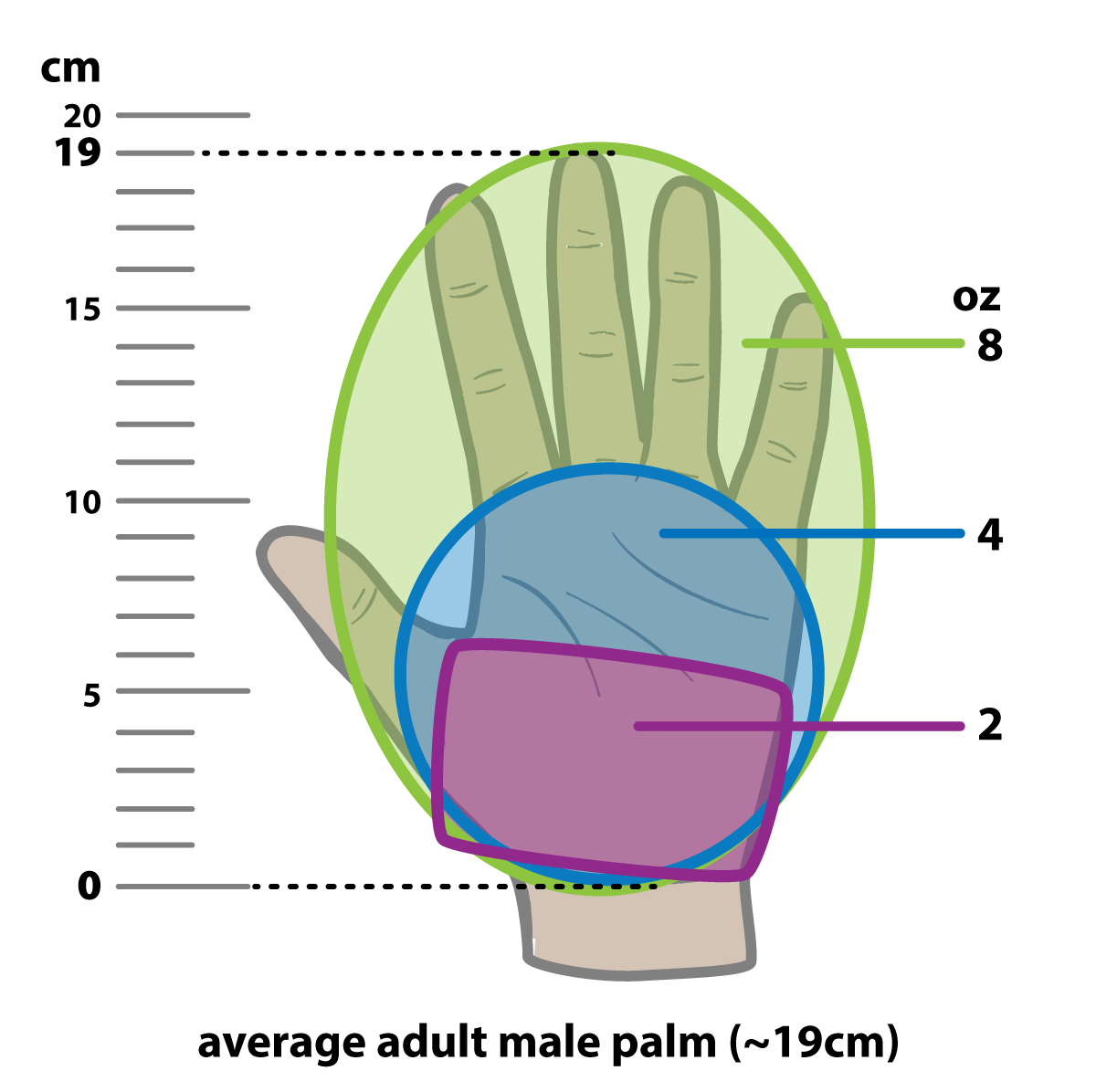
Use the palm of your hand to visually gauge the size of your fish meal
- half of your palm is approximately 2 ounces of fish
- your whole palm is approximately 4 ounces of fish
- the palm of your hand including your fingers is approximately 8 ounces of fish, (half a pound, or approximately a fillet of dinner plate length, or an average fish meal of 227 grams). This amount is the basis for the consumption advice in the advisory tables
The fish conversion table converts one fish meal of 227 grams (8 ounces, half a pound) into roughly the same number of fish fillets (note that one fish contains two fillets). Use the table to relate the number of fish fillets to the number of allowable fish meals we provide in the fish consumption advisory tables.
For example, the table shows that one meal (227 grams, 8 ounces, or half a pound) of 30 cm Brook Trout is equivalent to approximately three fillets. If the consumption advisory for a 30 cm Brook Trout is 2 meals per month, one person could safely eat 6 fillets in one month (2 meals per month × 3 fillets per meal = 6 fillets per month).
| Fish species | 15 cm / 6 in | 20 cm / 8 in | 25 cm / 10 in | 30 cm / 12 in | 35 cm / 14 in | 40 cm / 16 in | 45 cm / 18 in | 50 cm / 20 in | 55 cm / 22 in | 60 cm / 24 in | 65 cm / 26 in | 70 cm / 28 in | 75 cm / 30 in |
|---|---|---|---|---|---|---|---|---|---|---|---|---|---|
| Atlantic Salmon | N/A | N/A | N/A | N/A | N/A | N/A | N/A | 0.5 | 0.4 | 0.3 | 0.2 | 0.2 | 0.1 |
| Bigmouth Buffalo | N/A | N/A | N/A | N/A | 1.8 | 1.2 | 0.8 | 0.6 | 0.4 | 0.3 | 0.2 | N/A | N/A |
| Black Crappie | 34 | 14 | 7 | 4 | 2.7 | N/A | N/A | N/A | N/A | N/A | N/A | N/A | N/A |
| Bluegill | 19 | 7 | N/A | N/A | N/A | N/A | N/A | N/A | N/A | N/A | N/A | N/A | N/A |
| Brook Trout | 25 | 10 | 5 | 3 | 1.9 | 1.3 | 0.9 | 0.6 | 0.5 | N/A | N/A | N/A | N/A |
| Brown Bullhead | 33 | 14 | 7 | 4 | 2.5 | 1.7 | N/A | N/A | N/A | N/A | N/A | N/A | N/A |
| Brown Trout | 22 | 9 | 4 | 2 | 1.4 | 0.9 | 0.6 | 0.5 | 0.3 | 0.3 | 0.2 | 0.2 | 0.1 |
| Channel Catfish | 40 | 16 | 7 | 4 | 2.5 | 1.6 | 1.1 | 0.8 | 0.6 | 0.4 | 0.3 | 0.3 | 0.2 |
| Chinook Salmon | N/A | 9 | 5 | 3 | 1.7 | 1.1 | 0.8 | 0.6 | 0.4 | 0.3 | 0.2 | 0.2 | 0.2 |
| Cisco(Lake Herring) | 38 | 15 | 7 | 4 | 2.4 | 1.5 | 1.0 | 0.7 | 0.5 | N/A | N/A | N/A | N/A |
| Coho Salmon | N/A | N/A | 4 | 3 | 1.6 | 1.1 | 0.7 | 0.5 | 0.4 | 0.3 | 0.2 | 0.2 | 0.2 |
| Common Carp | 27 | 11 | 6 | 3 | 2.1 | 1.4 | 1.0 | 0.7 | 0.5 | 0.4 | 0.3 | 0.3 | 0.2 |
| Freshwater Drum | 47 | 19 | 9 | 5 | 3.0 | 1.9 | 1.3 | 0.9 | 0.7 | 0.5 | 0.4 | 0.3 | 0.3 |
| Gizzard Shad | 33 | 14 | 7 | 4 | 2.4 | 1.5 | 1.1 | N/A | N/A | N/A | N/A | N/A | N/A |
| Goldeye | N/A | 22 | 10 | 5 | 2.8 | 1.7 | N/A | N/A | N/A | N/A | N/A | N/A | N/A |
| Goldfish | N/A | 6 | 4 | 2 | 1.7 | N/A | N/A | N/A | N/A | N/A | N/A | N/A | N/A |
| Lake Trout | N/A | 12 | 6 | 3 | 2.1 | 1.3 | 0.9 | 0.7 | 0.5 | 0.4 | 0.3 | 0.2 | 0.2 |
| Lake Whitefish | 29 | 12 | 6 | 3 | 2.0 | 1.3 | 0.9 | 0.6 | 0.5 | 0.4 | 0.3 | 0.2 | N/A |
| Largemouth Bass | 24 | 10 | 5 | 3 | 1.7 | 1.1 | 0.8 | 0.6 | N/A | N/A | N/A | N/A | N/A |
| Ling (Burbot) | N/A | 32 | 16 | 9 | 5.9 | 4.0 | 2.8 | 2.0 | 1.5 | 1.2 | 0.9 | 0.7 | 0.6 |
| Longnose Sucker | N/A | 14 | 7 | 4 | 2.6 | 1.8 | 1.3 | 0.9 | 0.7 | 0.5 | N/A | N/A | N/A |
| Mooneye | N/A | 11 | 6 | 4 | 2.4 | 1.7 | 1.2 | 0.9 | 0.7 | N/A | N/A | N/A | N/A |
| Northern Pike | N/A | N/A | 17 | 10 | 6.0 | 4.0 | 2.8 | 2.0 | 1.5 | 1.2 | 0.9 | 0.7 | 0.6 |
| Pink Salmon | N/A | N/A | N/A | 3 | 2.0 | 1.3 | 0.9 | 0.6 | 0.5 | N/A | N/A | N/A | N/A |
| Pumpkinseed | 16 | 7 | 3 | N/A | N/A | N/A | N/A | N/A | N/A | N/A | N/A | N/A | N/A |
| Quillback Carpsucker | 11 | 6 | 3 | 2 | 1.6 | 1.2 | 0.9 | 0.7 | 0.6 | N/A | N/A | N/A | N/A |
| Rainbow Smelt | 33 | 14 | 8 | N/A | N/A | N/A | N/A | N/A | N/A | N/A | N/A | N/A | N/A |
| Rainbow Trout | N/A | 8 | 4 | 3 | 1.7 | 1.1 | 0.8 | 0.6 | 0.4 | 0.3 | 0.3 | 0.2 | 0.2 |
| Redhorse Sucker | 30 | 12 | 6 | 3 | 2.1 | 1.4 | 1.0 | 0.7 | 0.5 | 0.4 | 0.3 | 0.2 | N/A |
| Rock Bass | 25 | 11 | 6 | 4 | N/A | N/A | N/A | N/A | N/A | N/A | N/A | N/A | N/A |
| Round Whitefish | N/A | 18 | 9 | 5 | 2.8 | 1.8 | 1.2 | 0.8 | 0.6 | N/A | N/A | N/A | N/A |
| Sauger | 39 | 16 | 8 | 5 | 2.9 | 1.9 | 1.3 | 1.0 | 0.7 | 0.5 | N/A | N/A | N/A |
| Siscowet | N/A | N/A | N/A | 4 | 2.3 | 1.4 | 1.0 | 0.7 | 0.5 | 0.3 | 0.3 | 0.2 | 0.2 |
| Smallmouth Bass | 35 | 14 | 7 | 4 | 2.4 | 1.6 | 1.1 | 0.8 | 0.6 | N/A | N/A | N/A | N/A |
| Splake | 27 | 10 | 5 | 3 | 1.7 | 1.1 | 0.7 | 0.5 | 0.4 | 0.3 | 0.2 | 0.2 | N/A |
| Walleye | 37 | 15 | 7 | 4 | 2.6 | 1.7 | 1.2 | 0.8 | 0.6 | 0.5 | 0.4 | 0.3 | 0.2 |
| White Bass | 41 | 17 | 8 | 5 | 3.0 | 2.0 | N/A | N/A | N/A | N/A | N/A | N/A | N/A |
| White Crappie | 37 | 16 | 9 | 5 | 3.4 | N/A | N/A | N/A | N/A | N/A | N/A | N/A | N/A |
| White Perch | 37 | 15 | 7 | 4 | 2.4 | N/A | N/A | N/A | N/A | N/A | N/A | N/A | N/A |
| White Sucker | 35 | 14 | 7 | 4 | 2.6 | 1.7 | 1.2 | 0.9 | 0.6 | 0.5 | N/A | N/A | N/A |
| Yellow Perch | 25 | 10 | 5 | 3 | 1.8 | N/A | N/A | N/A | N/A | N/A | N/A | N/A | N/A |
How to interpret consumption advice for the general population
Consumption advice for the general population is based on an average meal of 227 grams (8 ounces, half a pound) of a skinless, boneless dorsal fillet (meaning a fillet of dinner plate length) for an average size adult weighing 70 kilograms (154 pounds).
We assume that smaller individuals would consume a smaller portion and larger individuals would consume a larger portion.
If you are an average size adult and your meal is substantially more than 227 grams (8 ounces, half a pound), you should consume fewer than the recommended number of meals.
Read the General advice to reduce risks when eating fish on this page for more information.
How to interpret consumption advice for anyone who is pregnant or may become pregnant and children under 15
The sensitive population includes:
- anyone who is pregnant or may become pregnant
- children younger than 15 years of age
These groups are referred to as the sensitive population because they are more sensitive to contaminants. The health of fetuses, babies and children can be affected by contaminants such as mercury and polychlorinated biphenyls(PCBs). Young children and developing fetuses are affected by contaminants, such as mercury and polychlorinated biphenyls, at lower levels than the general population.
This guide advises the sensitive population to:
- eat fish that can be consumed from four to 32 meals per month
- avoid eating fish with consumption advisories of less than four meals per month
Read our advice on how the sensitive population can further reduce the risk of contamination from fish caught in Ontario waters if they also eat store-bought or commercial fish four times or more in a month.
Eating fish that is larger or smaller than the advisory table range
The advisory tables do not list all types and sizes of fish at that location. They only list the size and type of fish that have been tested for contaminants. Since it is well known that contaminant levels generally increase with fish length, you can apply the following rules:
- for fish smaller than the advisory table range, follow the advice for the smallest tested range
- for fish larger than the advisory table range, it is difficult to provide consumption advice. Generally, you should not eat many fish larger than what is listed on the consumption advisory table.
If you have questions about how to determine the amount of fish that is safe to consume, contact the Fish Contaminant Monitoring Program:
General advice on how to reduce your risk when eating fish
Quick tips to reduce the risk from contaminants in fish
- Eat smaller fish. Smaller fish tend to be much less contaminated than larger fish of the same species.
- Eat leaner fish from the Great Lakes. Species such as Bass, Pike, Walleye, Perch and fish small enough to cook whole in a pan (referred to as panfish) tend to have lower contaminants than fatty species like Salmon and Trout. Cook fatty fish from the Great Lakes on a rack or grill to let fat, and contaminants along with it, drip away.
- Eat panfish or whitefish from inland locations. Top-predatory fish such as Pike and Walleye generally have greater contaminants than panfish or whitefish.
Fish organs
Do not eat organs of any fish. Fish organs can be high in both heavy metals and pesticides. They may also contain high levels of algal toxins.
Fish eggs
Eggs can have elevated levels of organic contaminants because of their higher fat content.
Do not eat the eggs of fatty fish, such as Salmon and Trout from the Great Lakes, as they generally contain higher levels of contaminants.
Fish with black spots, tumours and/or worms
Fish can sometimes have worms, grubs and cysts:
- in their flesh
- around the intestines
- on the skin, fins or gills
These parasites are a normal part of the ecosystem. The edible portions of a fish (fillets) that contains parasites are not a health hazard if the fish is properly cooked.
Occasionally, you may catch a fish with external growths, tumours, sores or other lesions. These generally result from viral or bacterial infections. In general, there are no significant differences in contaminant levels of fish with or without tumors from the same waterbody. While the appearance of viral or bacterial infections in fish is unsightly, there is no known health risk from consuming an infected fish, that meets the consumption advisories, as long as the fish is cooked properly.
Sick, dying or dead fish
As a general precaution, avoid eating fish that appear to be sick, dying or dead when caught. These fish may contain harmful microorganisms or toxins.
For more information on some of these diseases, visit Fish and wildlife health.
Algal blooms
Some blue-green algae can produce toxins called microcystins.
Recent studies showed that these toxins do not accumulate at high levels in fish fillets. This means there is a very low risk to human health, even from eating fish caught during peak blue-green algal bloom condition.
One exception is that elevated levels of microcystins have been found in the livers of fish from waterbodies that regularly experience blue-green algal blooms, even if a bloom is not present. To eliminate this risk, follow the general advice to avoid eating any fish organs.
Freshwater clams
Clams are filter feeders and are usually low in contaminants, but you should avoid eating them because they can contain harmful bacteria and other pathogens.
Contaminants from store-bought or commercial fish
Most but not all fish purchased from stores are low in contaminants.
The sensitive population (anyone who is pregnant or may become pregnant and children under 15) should:
- reduce their consumption of fish caught from Ontario waters by one meal per month for every two meals of store-bought or commercial fish, including canned fish
- not consume Ontario fish if they also eat Shark, Swordfish or fresh or frozen Tuna, Health Canada suggests these fish should be consumed only occasionally
For more advice on store-bought fish, contact:
Preserving and preparing fish for cooking
If you decide to keep and eat your catch, make sure to:
- chill freshly caught fish on ice or in a refrigerator as soon as possible to avoid spoilage
- clean, dress and refrigerate or preserve the fish as soon as possible
Clean and cook fish to reduce contaminants
Toxins, such as polychlorinated biphenyls (PCBs), pesticides and dioxins concentrate to the highest levels in fish with fatty flesh, such as Salmon, Trout, Carp and Catfish.
Before cooking:
- remove the skin
- trim off the fatty areas
- discard the flesh around the belly area
You can further reduce contaminants by allowing fat to drip away during cooking by grilling, broiling or baking the fish.
If you deep fry fish, do not re-use the oil.
Some toxins such as mercury and perfluorooctane sulfonic acid (a PFAS compound), are evenly distributed in fish flesh so there is nothing you can do to reduce or remove them.
How to trim and cook fish to reduce certain contaminants
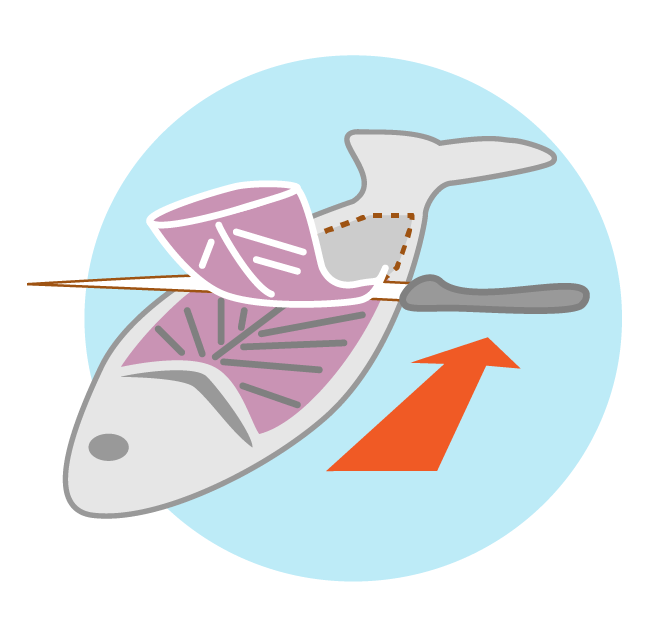
Remove fish fillet.
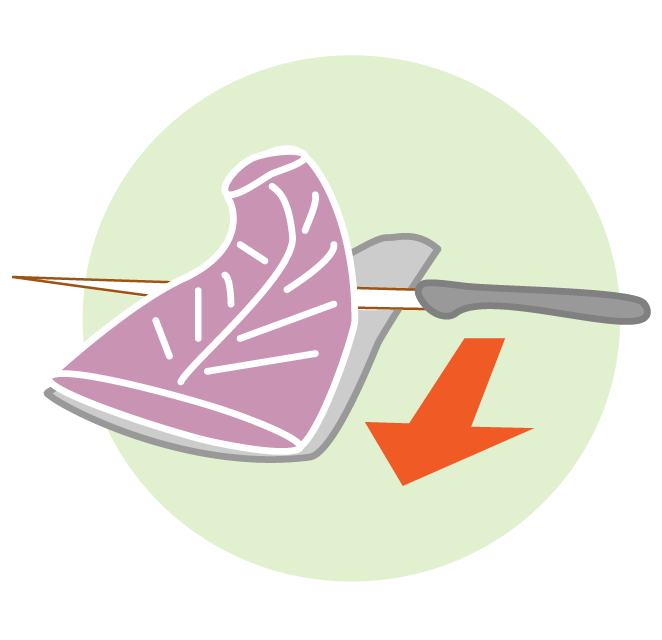
Remove the skin and fat along the side and belly of the fillet.
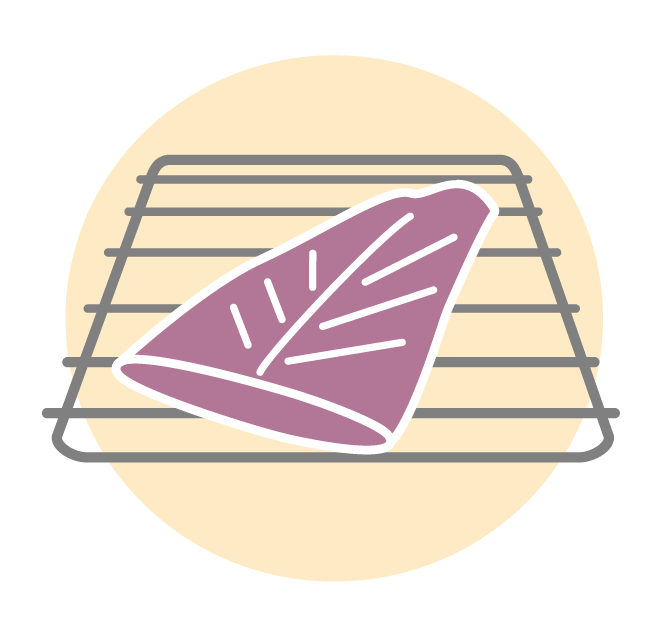
Cook fish fillet on a rack or grill to let fat drip away.
Contaminants in fish
The contaminants found in fish can come from local sources and from sources thousands of kilometres away.
Airborne contaminants can travel long distances in the atmosphere and return to the earth in rain and snowfall. Mercury, polychlorinated biphenyls (PCBs) and toxaphene:
- are known to be transported long distances
- can cause low-level contamination even in isolated lakes and rivers
Although fish from many locations listed in the guide have been tested for a wide variety of contaminants, most of the consumption restrictions are caused by mercury and PCBs.
Superscripts (small numbers) next to the name of the fish species in the advisory tables identify the contaminant or group of contaminants causing consumption restrictions within a given species and location.
Contaminants corresponding to the superscripts are listed here.
1. Mercury
Mercury is converted to methylmercury and absorbed by a fish either from water passing over its gills or it is ingested with its diet. Since fish eliminate mercury at a very slow rate, concentrations of this substance gradually increase. Fish at the top of the food web such as Walleye and Pike usually have the highest mercury levels.
2. Polychlorinated biphenyls (PCBs)
PCBs are a group of chlorinated organic compounds first commercially developed in the late 1920s and banned in the 1970s. They persist for decades in the natural environment and readily accumulate in the aquatic ecosystem.
3. Dioxin-like PCBs
These are a select group of PCBs with harmful properties similar to dioxins.
4. Dioxins and furans
Dioxins and furans are unintentional by-products of several industrial processes and, in some cases, incomplete combustion. Of 210 different dioxins and furans, 17 are toxic enough to be of concern.
5. Toxaphene
Toxaphene is an extremely persistent insecticide in the aquatic environment. It was removed from general use in Canada in 1974 and restricted in the United States in 1982.
6. Perfluoroalkyl and polyfluoroalkyl substances (PFAS)
PFAS are a family of chemicals that make materials water, stain and oil repellent. They have been in a wide array of consumer products since the 1950s. PFAS do not break down easily. Most consumption restrictions due to PFAS occur downstream of places where fire-fighting foam that historically contained PFAS was routinely used.
7. Selenium
Selenium is a metal found in fish tissue but only occasionally at levels requiring consumption restrictions.
8. Arsenic
Arsenic is a metal found in fish tissue but only occasionally at levels requiring consumption restrictions.
9. Polybrominated diphenyl ethers (PBDEs)
PBDEs are used as flame retardants in building materials, electronics and many household products. Some of these chemicals have been banned or phased out in recent years.
10. Polychlorinated naphthalenes (PCNs)
PCNs are industrial chemicals. While no longer used in Canada, they may be produced unintentionally in different chemical processes.
11. Chromium
Chromium is a metal found in fish tissue but infrequently at levels requiring consumption restrictions.
12. Photomirex
Read the mirex section (number 13) for information on photomirex.
13. Mirex
Mirex is a chlorinated carbon compound used as a pesticide in the southern United States. It was never registered for pesticide use in Canada. Some mirex is transformed into photomirex.
14. Lead
Metals such as lead are found in fish tissue but only occasionally at levels requiring consumption restrictions.
15. Cadmium
Cadmium is a metal found in fish tissue but rarely at levels requiring consumption restrictions.
16. Tin
Tin is a metal found in fish tissue but rarely at levels requiring consumption restrictions.
For more information on these substances, contact the Fish Contaminant Monitoring Program:
Fish contaminant monitoring program
How we select testing locations
It is not practical or economical to test fish from every water body in Ontario because we have:
- more than 250,000 lakes
- countless rivers and streams
- many local areas in the Great Lakes
We may select a location for testing for one or more of the following reasons:
- it is a popular angling area
- there is a known or suspected source of pollution nearby
- it is a major source of food for local residents
- it is being developed for recreation or industrial purposes
- there is an opportunity to collect samples through a partnership
- it is part of a monitoring program for long-term studies of contaminants in fish
How we select testing sites is an ongoing process. If you would like to provide input on testing sites, email us at fishguide@ontario.ca.
How we select fish species for testing
Most lakes and rivers contain a variety of fish species.
When we select species for contaminant testing, we consider that not all species accumulate a particular contaminant at the same rate. Two different species of fish of the same size may have different levels of contaminants because different species of fish:
- feed on different things
- prefer different habitats
- grow at different rates
- are physiologically different
For example, Walleye (Pickerel) and Northern Pike are likely to contain higher levels of mercury than Whitefish of the same size. This is because Walleye and Pike are top predators and feed on smaller fish that may also contain elevated mercury levels. Whitefish feed lower down in the food chain on aquatic insects and invertebrates which contain less mercury than small fish. Whitefish livers also appear to be better at removing mercury from their body.
Testing for mercury
When we test fish for mercury in a specific area, the practice is to start with species that are top predators because they likely indicate the highest mercury levels.
If low levels of mercury are found in predators, testing other species may not be necessary.
Testing for organic contaminants
When we test for organic contaminants such as PCBs and mirex, species with high fat levels, such as Salmon, Trout, Carp and Catfish are selected since organic chemicals tend to accumulate in fatty tissue.
If these species do not contain excessive levels of organic contaminants, then species with less fat from the same location may not have to be tested.
How we collect and test fish
Fish samples are collected and tested by:
- the Ministry of Natural Resources and Forestry
- the Ministry of the Environment, Conservation and Parks
- other agencies
We use various methods to collect fish samples.
Whenever possible, the selection includes 10 or more fish of each species with lengths and weights representative of the size range of that species in the locations being tested. We record the length, weight and sex of each fish.
We remove a skinless, boneless fillet of dorsal muscle flesh from the fish. The fish is packaged, frozen and shipped to the Ministry of the Environment, Conservation and Parks laboratory in Toronto. At the lab, samples are processed and analyzed for contaminants using a variety of methods, depending on the contaminant.
We only provide consumption advisories for species that were tested for contaminants at a particular location.
Retesting of locations
Since the mid-1970s, the Fish Contaminant Monitoring Program has continued to:
- add new locations each year
- retest many lakes and rivers when necessary
In areas that are remote from human activity, where fish are relatively unaffected by pollution, any consumption restrictions are usually limited to elevated mercury levels in the larger and older predatory species such as Walleye and Northern Pike. The source of mercury in these areas can be natural or from long-range atmospheric transport and deposition through precipitation. As a result, concentrations in fish may not change substantially over time.
In areas more directly affected by human sources of pollution, the number of possible contaminants may be much larger, and the levels found in fish can be significantly affected by changes in the levels of pollution.
Retested locations are divided into three general groups:
- Areas where contaminant levels for one or more pollutants are unusually elevated or change substantially. These areas are retested every one to five years, depending on their popularity or whether they are a major food source for local communities.
- Areas that show no signs of substantial changes in contaminant levels >but are very popular fishing areas. These areas are retested approximately every five to twenty years.
- All other areas, usually relatively remote locations with no major sources of pollution and no indication of changing contaminant levels in fish. These areas are retested approximately every 10-50 years.
Learn how to identify fish
These are the fish you are most likely to catch in Ontario. Visit the species page to learn how to correctly identify the species of fish you caught.
Prohibited and restricted species
More information on whether the following species can be legally caught and harvested is available in the Ontario Fishing Regulations Summary.
Muskellunge
To maintain healthy Muskellunge populations, the Ministry of Natural Resources and Forestry encourages catch and release of this species because it cannot handle the pressures of heavy fishing.
Muskellunge will also likely have elevated levels of mercury and should not be consumed by anyone.
Lake Sturgeon
Recreational fishing for Lake Sturgeon in areas where populations are listed as threatened under the Endangered Species Act is restricted.
Catch and release of Lake Sturgeon is still permitted in areas where populations are not identified as threatened.
American Eel
Recreational fishing for American Eel is prohibited because the species is listed as endangered under the Endangered Species Act.
If you catch an American Eel, you must release it. You can also help us learn where they currently are in Ontario by reporting a sighting of an endangered animal to the Natural Heritage Information Centre.
Learn to fish
The Learn to Fish Program is a free program that teaches new anglers how to fish in Ontario.
Join a family-friendly fishing experience that includes a series of fun and engaging activities and then take to the shore to reel in your first catch.


